What is the effect of the reducing energy?
RUMM-USA is an innovative company specialising in energy management software and systems which are continually being updated and developed for energy management by energy managers. This is a distinction from the majority of software in this area that have been developed form an IT perspective. RUMM’S energy managers provide the input into the development based upon what they need to provide the best service for their customers.
If you are a commercial or industrial consumer then RUMM-USA can help you understand the costs, legislation and opportunities for cost and energy reductions open to you. Moreover they will help you deliver real energy and cost reductions and, for a lot of organisations, represent the best energy management option as they bring expertise and people to your site to help.
Their recent participation at the Forge Fair Trade show has been a huge success for RUMM-USA LLC. The forging and heat treatment community has shown a lot of interest in the RUMM process and technology which can assist the sector in reducing energy consumption and costs.
At a time when energy consumption, and its effective and efficient management, is high on everyone’s agenda in the manufacturing industry – RUMM was able to show how its processes can help you to Reduce Energy consumption.

Reduce energy consumption and save money

Have you or any member of staff ever asked any of these questions?
Do we use too much energy?
Are we paying too much for energy?
How can we reduce energy consumption?
If you have asked one or more of these questions; then it’s time to take action. You might be wondering where or how to start. Speak to the leading experts in Business energy reduction.
RUMM Business energy reduction UK establishes Exciting Partnership with Turbine Efficiency for Spanish Opportunity.
RUMM have begun working with Turbine Efficiency Power Services Limited, who specialise in providing electrical power solutions globally. The company is progressive and fast growing and has developed a holistic approach to the power needs of its customers.
With Turbine Efficiency looking after the energy supply side for their customers, RUMM will concentrate on reducing the amount of energy consumed by the user.
The first opportunity to develop a Supply & Demand offering with Turbine Efficiency has been at a large chemical manufacturing facility in Barcelona (pictured above). Following an extensive site study (in the January sun!) a full analysis will be undertaken by both companies to understand how much the customer could benefit from a joint Supply & Demand Side Management approach.
RUMM are very pleased to be linked to such a progressive company as Turbine Efficiency. We are excited by the business prospects and customer benefits that should result from this offering.
Enjoying some winter sun is to be welcomed too!
Reduce Business Energy Consumption




RUMM have an excellent track record that has taken them to greater heights with their Energy Management Services and Systems. RUMM offer a first class world renowned service and are committed to business energy reduction. RUMM take their commitment seriously with expanding to the USA, opening up world class offices. I found this recent case study by which RUMM have assisted Doncaster, Blaenavon achieved excellent results in reducing energy consumption and savings.
The Client
Doncasters is a leading international engineering group. It manufactures precision components and assemblies for the aerospace, industrial gas turbines, specialist automotive fasteners and petrochemical markets. Doncasters excels at working with alloys and metals that are difficult to shape and form.
The Brief
With an energy bill of £1.4million at the Doncasters’ Blaenavon site, RUMM was asked to look at ways of reducing energy consumption thus improving profits. The main focus of this was to design and install an automatic monitoring and targeting system (aM&T) to monitor consumption.
The Method

RUMM installed an aM&T system which provided Doncasters with half hourly data in order to identify those areas where savings could be made.
To ensure everyone was able to understand how the system worked and where the plant was using excess energy, the RUMM team worked closely with the incumbent energy team, in order to identify how electricity and gas were being distributed and the key areas in which they were being used.
The Results
By evaluating opportunities for savings within the thermal efficiency field, and optimising ‘waste heat’ to minimise temperature dissipation, RUMM was able to bring energy consumption down by 27%, giving the Blaenavon plant a saving of £1million over 2 years, against a 40% increase in sales.
This success contributed to Doncasters receiving an Energy Management Award. Such was the success of the work in Blaenavon, Doncasters also asked RUMM to install its energy management solution at four other plants in the UK. Since installation, a total of £3.6million has been saved in energy consumption costs, equating to 11,800 tonnes of CO2 emissions.
Why it worked
Using RUMM’s technology and energy management expertise allowed Doncasters to clearly identify those areas of high energy consumption and focus its efforts in order to set specific objectives that reduced energy consumption. As well as looking at existing manufacturing methods, the company was able to test, prior to installation, proposed new systems to evaluate future energy consumption.
“The service we have had from RUMM has been first class. Such was the project’s initial success, we installed at a further four sites and continue to look at other sites where RUMM’s intelligent monitoring can be used”
Group Energy Manager, Doncasters
Do you need help in reducing energy consumption and therefore save money? Would you like your company to achieve excellent results in Energy Reduction in Manufacturing?
Make your own solar cell with the below instructions
Energy Saving Solution
Make a solar cell in your kitchen
Saving energy is vitally important in these current times. One can explore energy saving systems, however these can be very expensive , we have decided to show you how to make your own solar cell, which is a device for converting energy from the sun into electricity. The high-efficiency solar cells you can buy at Radio Shack and other stores are made from highly processed silicon, and require huge factories, high temperatures, vacuum equipment, and lots of money.
If we are willing to sacrifice efficiency for the ability to make our own solar cells in the kitchen out of materials from the neighborhood hardware store, we can demonstrate a working solar cell in about an hour.
Our solar cell is made from cuprous oxide instead of silicon. Cuprous oxide is one of the first materials known to display the photoelectric effect,in which light causes electricity to flow in a material.
Thinking about how to explain the photoelectric effect is what led Albert Einstein to the Nobel prize for physics, and to the theory of relativity.
Materials you will need
The solar cell is made from these materials:
- A sheet of copper flashing from the hardware store. This normally costs about $5.00 per square foot. We will need about half a square foot.
- Two alligator clip leads.
- A sensitive micro-ammeter that can read currents between 10 and 50 microamperes. Radio Shack sells small LCD multimeters that will do, but I used a small surplus meter with a needle.
- An electric stove. My kitchen stove is gas, so I bought a small one-burner electric hotplate for about $25. The little 700 watt burners probably won't work -- mine is 1100 watts, so the burner gets red hot.
- A large clear plastic bottle off of which you can cut the top. I used a 2 liter spring water bottle. A large mouth glass jar will also work.
- Table salt. We will want a couple tablespoons of salt.
- Tap water.
- Sand paper or a wire brush on an electric drill.
- Sheet metal shears for cutting the copper sheet.
How to build the solar cell
My burner looks like this:

The first step is to cut a piece of the copper sheeting that is about the size of the burner on the stove. Wash your hands so they don't have any grease or oil on them. Then wash the copper sheet with soap or cleanser to get any oil or grease off of it. Use the sandpaper or wire brush to thoroughly clean the copper sheeting, so that any sulphide or other light corrosion is removed.
Next, place the cleaned and dried copper sheet on the burner and turn the burner to its highest setting.
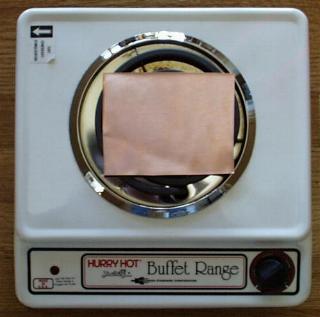
As the copper starts to heat up, you will see beautiful oxidation patterns begin to form. Oranges, purples, and reds will cover the copper.
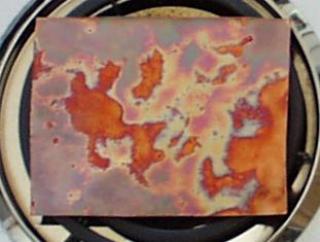
As the copper gets hotter, the colors are replaced with a black coating ofcupric oxide. This is not the oxide we want, but it will flake off later, showing the reds, oranges, pinks, and purples of the cuprous oxide layer underneath.

The last bits of color disappear as the burner starts to glow red.
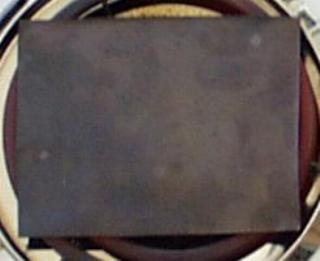
When the burner is glowing red-hot, the sheet of copper will be coated with a black cupric oxide coat. Let it cook for a half an hour, so the black coating will be thick. This is important, since a thick coating will flake off nicely, while a thin coat will stay stuck to the copper.
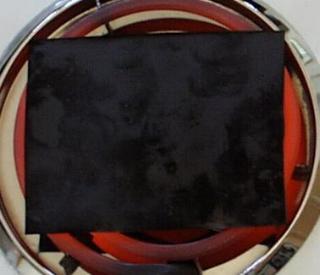
After the half hour of cooking, turn off the burner. Leave the hot copper on the burner to cool slowly. If you cool it too quickly, the black oxide will stay stuck to the copper.

As the copper cools, it shrinks. The black cupric oxide also shrinks. But they shrink at different rates, which makes the black cupric oxide flake off.

The little black flakes pop off the copper with enough force to make them fly a few inches. This means a little more cleaning effort around the stove, but it is fun to watch.
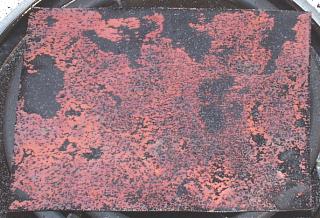
When the copper has cooled to room temperature (this takes about 20 minutes), most of the black oxide will be gone. A light scrubbing with your hands under running water will remove most of the small bits. Resist the temptation to remove all of the black spots by hard scrubbing or by flexing the soft copper. This might damage the delicate red cuprous oxide layer we need to make to solar cell work.
The rest of the assembly is very simple and quick.
Cut another sheet of copper about the same size as the first one. Bend both pieces gently, so they will fit into the plastic bottle or jar without touching one another. The cuprous oxide coating that was facing up on the burner is usually the best side to face outwards in the jar, because it has the smoothest, cleanest surface.
Attach the two alligator clip leads, one to the new copper plate, and one to the cuprous oxide coated plate. Connect the lead from the clean copper plate to the positive terminal of the meter. Connect the lead from the cuprous oxide plate to the negative terminal of the meter.
Now mix a couple tablespoons of salt into some hot tap water. Stir the saltwater until all the salt is dissolved. Then carefully pour the saltwater into the jar, being careful not to get the clip leads wet. The saltwater should not completely cover the plates -- you should leave about an inch of plate above the water, so you can move the solar cell around without getting the clip leads wet.
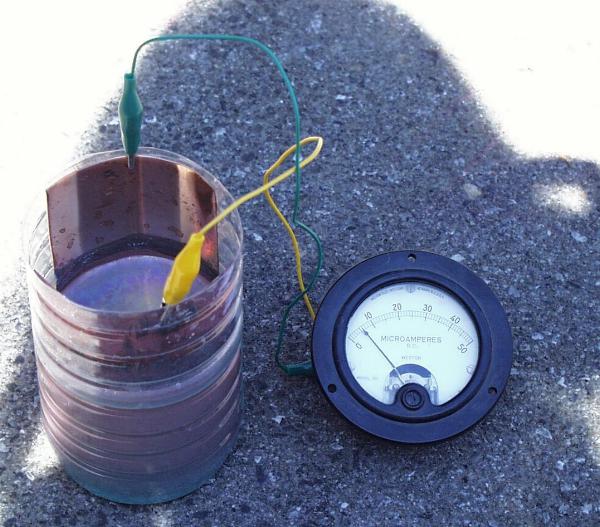
The photo above shows the solar cell in my shadow as I took the picture. Notice that the meter is reading about 6 microamps of current.
The solar cell is a battery, even in the dark, and will usually show a few microamps of current.